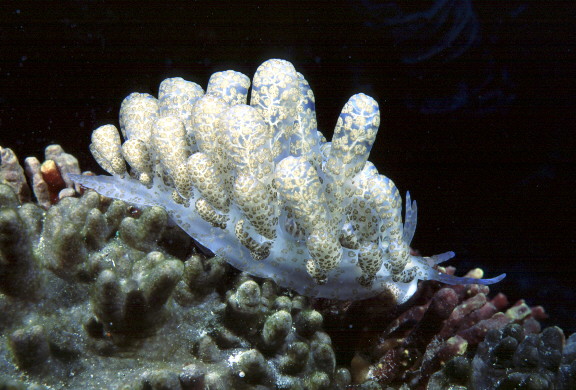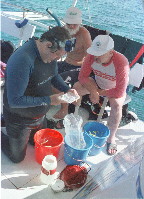
Phyllodesmium longicirra
Phyllodesmium longicirra Berg, 1905
Phyllodesmium longicirra is probably the largest aeolid in the Indo-Pacific. It may reach lengths exceeding 120 mm. Its golden brown patches in the cerata and on the body attest to the fact that it is one of the solar-powered nudibranchs. These are patches of zooxanthellae, the dinoflagellate algae that are also present in most reef corals and giant clams.
Phyllodesmium longicirra probably gets much of its supplemental nutrition from its zooxanthellae. While it feeds on octocorals, it is most often observed crawling about on sand and rubble bottoms, away from any obvious prey. Many other species of Phyllodesmium also have zooxanthellae, but the association is most highly developed in P.longicirra, where the elaborate branches of the ceratal ducts permit greater surface area for the symbionts.
Phyllodesmium longicirra was originally described from Indonesia by Danish brancher, Rudolf Bergh in 1905 where it was collected during the famous Siboga Expedition which explored much of the Indonesian waters. It has also been found in Australia and New Guinea. It appears to be restricted to the western margin of the Pacific.
Photo/text courtesy of Mary Jane Adams of Arcadia, California:

The first one I found was tucking under a ledge with just the cerata sticking out. It looked like a soft coral, but when touched, it reacted by shrinking up. The specimen in the above photo was found by my son John on a dive in the Milne Bay Province of PNG. After descending along the anchor chain, we found a wobbegong shark ten feet to the left of the anchor that occupied us for half the dive. While I finished photographing the wobby, John found this nudibranch ten feet to the right of the anchor. It was the least swimming I have ever done on a dive! Send Mary Jane mail at mjadams@earthlink |
Taxonomic information courtesy of:

California Academy of Sciences Send Terry mail at tgosliner@Calacademy.org |
<
